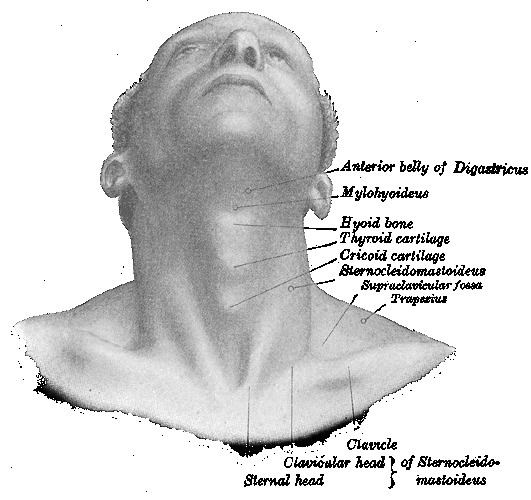Latin Prominentia laryngea TA A06.2.02.003 | Dorlands/Elsevier 12669875 FMA 55304 | |
 | ||
Precursor 4th and 6th pharyngeal arches | ||
The Adam's apple, or laryngeal prominence is a feature of the human neck, and is the lump or protrusion that is formed by the angle of the thyroid cartilage surrounding the larynx.
Contents
Structure
The structure of the Adam's apple forms a bump under the skin. It is typically larger in adult men, in whom it is usually clearly visible and palpable. In women, the bump is much less visible and is hardly perceived on the upper edge of the thyroid cartilage.
The meeting point of the two portions of the cartilage generally forms an acute angle (of about 90°) in men, while in women it forms an open arc (of about 120°).
Sex difference
Although both sexes have an Adam's apple it is considered to be a characteristic feature of adult men, because its size tends to increase considerably during puberty.
Its development is considered a secondary sexual characteristic of males that appears as a result of hormonal activity. Its level of development varies among individuals and the widening of that area in the larynx can occur very suddenly and quickly.
The Adam's apple is more prominent in adult males than in females because of the difference in the size of the angle: 90° in males and 120° in females.
Function
The Adam's apple, in conjunction with the thyroid cartilage which forms it, helps to protect the walls and the frontal part of the larynx, including the vocal cords (which are located directly behind it).
Another function of the Adam's apple is related to the deepening of the voice. During adolescence, the thyroid cartilage grows together with the larynx. Consequently, the laryngeal prominence grows in size mainly in men. Together, a larger soundboard is made up in phonation apparatus and, as a result, the man gets a deeper voice note.
Society and culture
Cosmetic surgery to reduce the size of the Adam's apple is called chondrolaryngoplasty (thyroid cartilage reduction). The surgery is effective, such that complications tend to be few and, if present, transient.
Etymology
There are two main theories as to the origin of the term "Adam's apple". The "Brewer's Dictionary of Phrase and Fable" and the 1913 edition of Webster's Dictionary point at an ancient belief that a piece of forbidden fruit was embedded in Adam's throat (the first man, according to Abrahamic religions). However, neither the Bible nor other Judeo-Christian or Islamic writings mention such a story. In fact, the biblical story does not even specify the type of fruit that Adam ate.
Linguist Alexander Gode claimed that the Latin phrase to designate the laryngeal prominence was very probably translated incorrectly from the beginning. The phrase in Latin was "pomum Adami" (literally: 'Adam's apple'). This, in turn, came from the Hebrew "tappuach ha adam" meaning "apple of man". The confusion lies in the fact that in Hebrew language the proper name "Adam" (אדם) literally means "man", while the Hebrew word "apple" means "swollen", thus in combination: the swelling of a man. Proponents of this version contend that the subsequent phrases in Latin and other Romance languages represent a mistranslation from the start.
The medical term "prominentia laryngea" (laryngeal prominence) was introduced by the Basle Nomina Anatomica in 1895.
In the American South, goozle is used colloquially to describe the Adam's apple, likely derived from guzzle.
